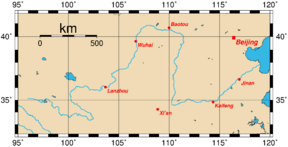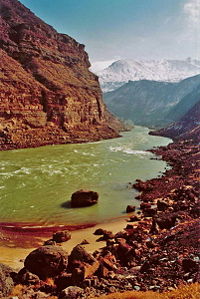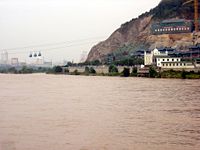Yellow River
| Yellow River (Huang He) | |
|---|---|
| | |
| Origin | Bayankala Mountains, Qinghai Province |
| Mouth | Bohai Sea |
| Basin countries | China |
| Length | 4845 km (3395 mi) |
| Source elevation | 4500 m (14,765 ft) |
| Avg. discharge | 2,571 m³/s (90,808 ft³/s) |
| Basin area | 752 000 km² |
Yellow River or Huang He (Traditional Chinese: 黃河; Simplified Chinese: 黄河; Hanyu Pinyin: Huáng Hélisten ▶; Wade-Giles: Hwang-ho, sometimes simply called the River in ancient Chinese, Mongolian: Hatan Gol) is the second longest river in China (after the Yangtze River) and the seventh longest in the world, at 4,845 km (3,395 mi) long.[1] Originating in the Bayankala Mountains in Qinghai Province in western China, it flows through nine provinces of China and empties into the Bohai Sea. The Yellow River basin has an east-west distance of 1900 km, and north-south distance of 1100 km. Total basin area is 752,443 km².
The Yellow River is called the "Mother River of China" and "the Cradle of Chinese Civilization" in China, as its basin is the birth-place of the northern Chinese civilizations and the most prosperous region in early Chinese history. But frequent devastating flooding, largely due to the elevated river bed in its lower course, has also earned it the unenviable distinction as "China's Sorrow."
Name
Early Chinese literature refers to the Yellow River simply as He (河), or "River." The first appearance of the name "Yellow River" (黄河) is in the Book of Han (汉书) written in the Western Han dynasty (206 B.C.E.–AD 9). The name "Yellow River" describes the perennial ochre-yellow colour of the muddy water in the lower course of the river. (The yellow deposits are also known as loess)
Sometimes the Yellow River is poetically called the "Muddy Flow" (Chinese: 濁流; pinyin: Zhuo Liu). The Chinese expression "when the Yellow River flows clear" is similar to the English expression "when hell freezes over."
Characteristics
The Yellow River is notable for the large amount of silt it carries — 1.6 billion tons annually at the point where it descends from the Loess Plateau. If it is running to the sea with sufficient volume, 1.4 billion tons are carried to the sea.
In modern times, since 1972 when it first dried, the river has dried in its lower reaches, from Jinan to the sea, in most years, in 1997 for 226 days. The low volume is due to increased demands for irrigation, by a factor of five since 1950. Water diverted from the river by 1999 served 140 million people and irrigated 74,000 km² of land. The highest volume occurs during the rainy season, from July to October, when 60% of the volume of the river flows. On the other hand, water for irrigation is needed between March and June. In order to capture excess water for use when needed and for flood control and electricity generation, several dams have been built, but due to the high silt load their life is expected to be limited. A proposed South-North Water Transfer Project involves several schemes to divert water from the Yangtze River, one in the western headwaters of the rivers where they are closest to one another, another from the upper reaches of the Han River, and a third using the route of the Grand Canal.
Due to its heavy load of silt the Yellow River is a depositing stream: that is, it deposits part of its carried burden of soil in its bed in stretches where it is flowing slowly. These deposits elevate the riverbed which flows between natural levees in its lower reaches. Should a flood occur, the river may break out of the levees into the surrounding lower flood plain and adopt a new course. Historically this has occurred about once every hundred years. In modern times, considerable effort has been made to strengthen levees and control floods.
The Yellow River Delta totals 8,000 square kilometers. However, since 1996 it has been reported to be shrinking slightly each year, through erosion.[2]
Geography
From its sources, Gyaring Lake and Ngoring Lake, high in the Bayankala Mountains in Qinghai Province in the far west of China, the Yellow River loops north, bends south, creating the "Great Bend," and then flows generally eastwards across northern China to the Gulf of Bohai, draining a basin of 752,443 km², which nourishes 120 million people.
The river is commonly divided into three stages. However, different scholars have different opinions in how the three stages are divided. This article adopts the division by the Yellow River Hydrology Committee.
Upper reaches
The upper reaches of the Yellow River is a segment starting from the source in the Bayankala Mountains and ending at Hekou County of Inner Mongolia just before turning sharply to the north. This segment has a total length of 2160 km (3470 mi) and total basin area of 386,000 km² (51.3% of total basin area). Along this length, the elevation of the Yellow River drops 3496 metres, with an average drop of 1%.
The upper reaches can be further divided into three sections: the source, valley, and alluvial plain section. The source section flows mainly through pastures, swamps, and knolls between the Bayankala Mountains and Anemaqen (Amne Machin) Mountains. The river water is clear and flows steadily. Crystal clear lakes are characteristics in this section. The two main lakes along this section are Lake bob (扎陵湖) and Lake Eling (鄂陵湖), having capacities of 4.7 billion and 10.8 billion m³, respectively. At elevations over 4260 m above sea level, they are the largest two plateau fresh water lakes in China.
The valley section stretches from Longyang Gorge in Qinghai to Qingtong Gorge in Gansu. Steep cliffs line both sides of the river. The water bed is narrow and the average drop is large, so the flow in this section is extremely turbulent and fast. There are 20 gorges in this section, the more famous of these being the Longyang, Jishi, Liujia, Bapan, and Qingtong Gorges. The flow conditions in this section makes it the best location to build hydroelectric plants.
After emerging from the Qingtong Gorge, the river comes into a section of vast alluvial plains, the Yinchuan Plain and Hetao Plain. In this section, the regions along the river are mostly deserts and grasslands, with very few tributaries. The flow is slow and on both sides of the river. The Hetao Plain has a length of 900 km and width of 30 to 50 km. It is historically the most important irrigation plain along the Yellow River.
Middle reaches
The part of Yellow River between Hekou County in Inner Mongolia and Zhengzhou in Henan constitutes the middle reaches of the river. The middle reaches has a length of 1206 km long and basin area of 344,000 km² (45.7% of total), with a total elevation drop of 890 meters, and average drop of 0.074%. There are 30 large tributaries along the middle reaches, and the water flow is increased by 43.5% on this stage. The middle reaches contributes 92% of the river's silts.
The middle stream of the Yellow River passes through the Loess Plateau where substantial erosion takes place. The large amount of mud and sand discharged into the river makes the Yellow River the most sediment-laden river in the world. The highest recorded annual level of silts discharged into the Yellow River is 3.91 billion tons in 1933. The highest silt concentration level was recorded in 1977 at 920 kg/m³.[citation needed] These sediments later deposit in the slower lower reaches of the river, elevating the river bed and creating the famous "river above ground." In Kaifeng, Yellow River is 10 meters above the ground level.[3]
From Hekou County to Yumenkou, the river passes through the longest series of continuous valleys on its main course, collectively called the Jinshan Valley. The abundant hydrodynamic resources stored in this section makes it the second most suitable area to build hydroelectric power plants. The famous Hukou Waterfall is in the lower part of this valley.
Lower reaches
In the lower reaches, from Zhengzhou to the sea, a distance of 786 km, the river is confined to a levee-lined course as it flows to the northeast across the North China Plain before emptying into the Bohai Sea. The basin area in this stage is only 23,000 km² (3% of total). The total drop in elevation of the lower reaches is 93.6 m, with an average drop of 0.012%.
The silts received from the middle reaches form sediments here, elevating the river bed. During 2000 years of levee construction, excessive sediment deposits have raised the riverbed several meters above the surrounding ground. Few tributaries add to the flow in this stage; nearly all rivers to the south drain into the Huai River, whereas those to the north drain into the Hai River.
Tributaries of the Yellow River
- White River (白河)
- Black River (黑河)
- Huang River (湟水)
- Zuli River (祖厉河)
- Qingshui River (清水河)
- Dahei River (大黑河)
- Kuye River (窟野河)
- Wuding River (无定河)
- Fen River (汾河)
- Wei River (渭河)
- Luo River (洛河)
- Qin River (沁河)
- Dawen River (大汶河)
Hydroelectric power dams on the Yellow River
Below is the list of hydroelectric power stations built on the Yellow River (in bracket is the year to start operation):
- Sanmen Gorge hydroelectric power station (1960)
- Sanshenggong hydroelectric power station (1966)
- Qingtong Gorge hydroelectric power station (1968)
- Liujia Gorge hydroelectric power station (1974)
- Yanguo Gorge hydroelectric power station (1975)
- Tianqiao hydroelectric power station (1977)
- Bapan Gorge hydroelectric power station (1980)
- Longyang Gorge hydroelectric power station (1992)
- Da Gorge hydroelectric power station (1998)
- Li Gorge hydroelectric power station (1999)
- Wanjiazhai hydroelectric power station (1999)
- Xiaolangdi hydroelectric power station (2001)
Provinces and cities on the Yellow River
Originating in the Bayankala Mountains, the Yellow River now passes nine provinces, namely Qinghai, Sichuan, Gansu, Ningxia, Inner Mongolia, Shaanxi, Shanxi, Henan and Shandong. The mouth of the Yellow River is located at Dongying, Shandong.
The provinces of Hebei and Henan derive their names from the Huang He. Their names mean respectively "north" and "south of the (Yellow) River."
Major cities located along the Yellow River include (starting from the source): Lanzhou, Wuhai, Baotou, Kaifeng, and Jinan.
Flooding and changing of course
- see also: List of natural disasters by death toll
The river is extremely prone to flooding. It has flooded 1593 times in last 3000-4000 years, while its main course changed 18 times. Historical maps from the Qin Dynasty indicate the Yellow River was flowing considerably North to the present course. Those maps showed after the river has passed Luoyang, it flows along the border of Shanxi and Henan Provinces, and continuing along the border of Hebei and Shandong before emptying to Bohai Bay near the present-day Tianjin.
Beginning in 1194, the Yellow River flowing to the north changed its course southwards by running into the Huai River. Since then the course of the river changed back and forth between the route of the Huai River and the original route of the Yellow River several times over the next 700 years. The consequent built up of silt deposit was so heavy that the Huai River is unable to flow through its historic course, after the Yellow River reverted to its northerly course for the last time in 1897. Instead the water pools up into Hongze Lake, and then runs southwards towards the Yangtze River.
Floods of the river account for some of the deadliest natural disasters ever recorded in human history. The flatness of North China Plain contributes to the deadliness of the floods. A slight rise in water level would mean a large portion of land would be completely covered in water. If a flood occurs, a portion of the population would initially die from drowning, followed by the spread of diseases and ensuing famine.
- In 1887 the river flooded the North China Plain causing an estimated 900,000–2,000,000 deaths.
- In 1931 the river flooded the North China Plain causing an estimated 1,000,000–4,000,000 deaths.
In 1938, during the Second Sino-Japanese War, the Nationalist troops under the orders of Chiang Kai-Shek broke the dike holding back the Yellow River in order to stop the advancing Japanese troops. This resulted in the flooding of an area covering 54,000 km² and the death of 500,000-900,000 people.
Several dams and flooding projects have been constructed along the Yellow River preventing any further floods of the river.
References and further reading
- ↑ Chinese history recorded that Yellow River has changed its course 18 times
- ↑ "Yellow River Delta Shrinking 7.6 Square Kilometers Annually," China Daily February 1, 2005, retrieved 14 September 2006 from http://china.org.cn/english/2005/Feb/119497.htm
- ↑ Yellow River: Geographic and Historical Settings
- Sinclair, Kevin. 1987. The Yellow River: A 5000 Year Journey Through China. (Based on the television documentary). Child & Associates Publishing, Chatswood, Sydney, Australia. ISBN 0-86777-347-2
- "China's Sorrow." Times Past: Pausing to Remember. <http://www.pausingtoremember.net/China's_sorrow.html>.
See also
- Grand Canal of China
- Geography of China
- North China Plain
- Loess Plateau
- List of rivers of Asia
- List of rivers in China
- Water resources of China
- Yellow Sea
- Yellow River Cantata
- 1938 Yellow River flood
External links
- Tibet is melting and turning into desert YouTube
- Yellow River Home Page at UMassD
- Yellow River delta Information at LSU
- Listen to the Yellow River Ballade from the Yellow River Cantata
- "A Troubled River Mirrors China’s Path to Modernity" New York Times November 19, 2006
am:ቢጫው ወንዝ sa:हुआंग हे नदी zh-classical:黃河
Credits
New World Encyclopedia writers and editors rewrote and completed the Wikipedia article in accordance with New World Encyclopedia standards. This article abides by terms of the Creative Commons CC-by-sa 3.0 License (CC-by-sa), which may be used and disseminated with proper attribution. Credit is due under the terms of this license that can reference both the New World Encyclopedia contributors and the selfless volunteer contributors of the Wikimedia Foundation. To cite this article click here for a list of acceptable citing formats.The history of earlier contributions by wikipedians is accessible to researchers here:
The history of this article since it was imported to New World Encyclopedia:
Note: Some restrictions may apply to use of individual images which are separately licensed.



